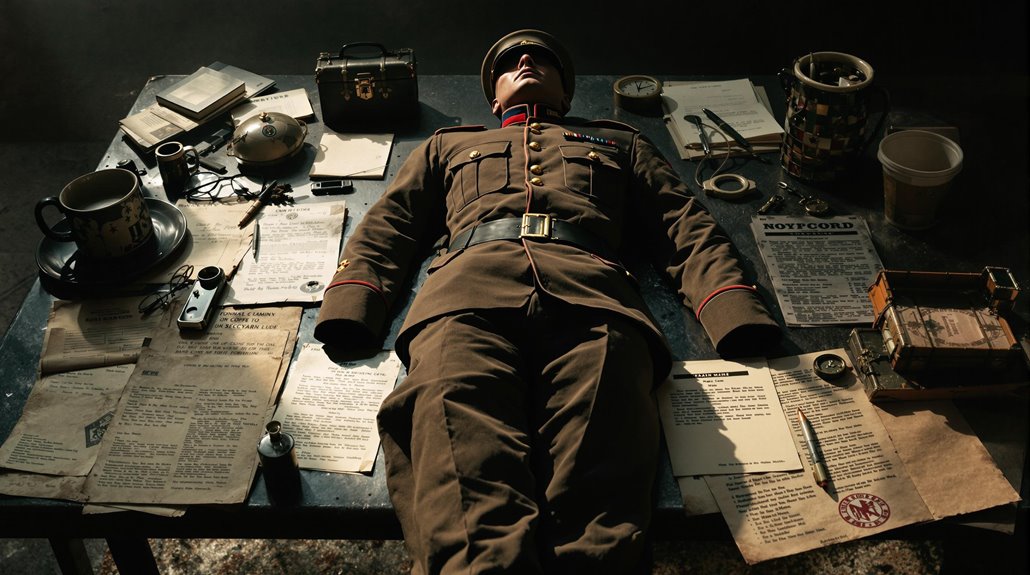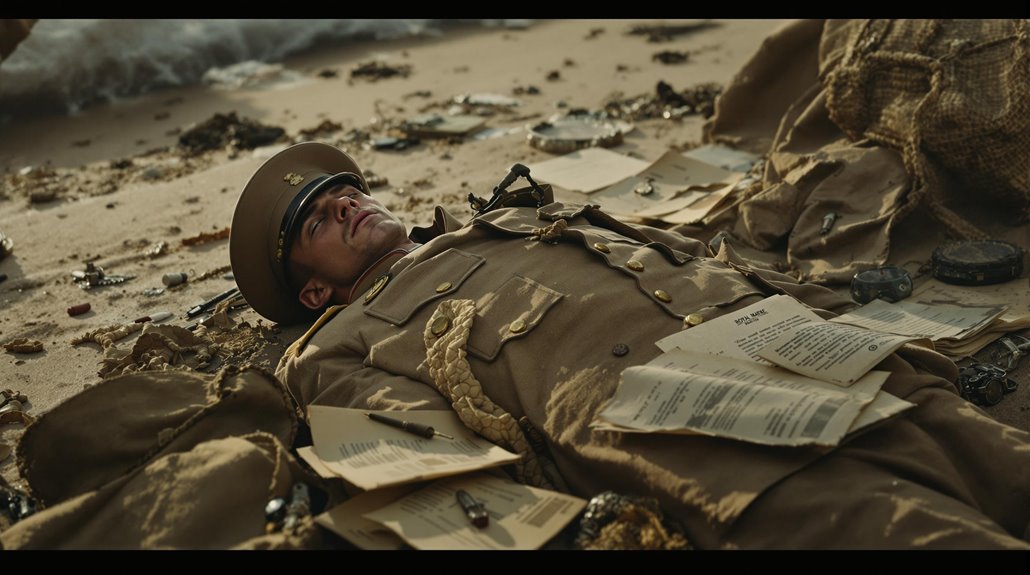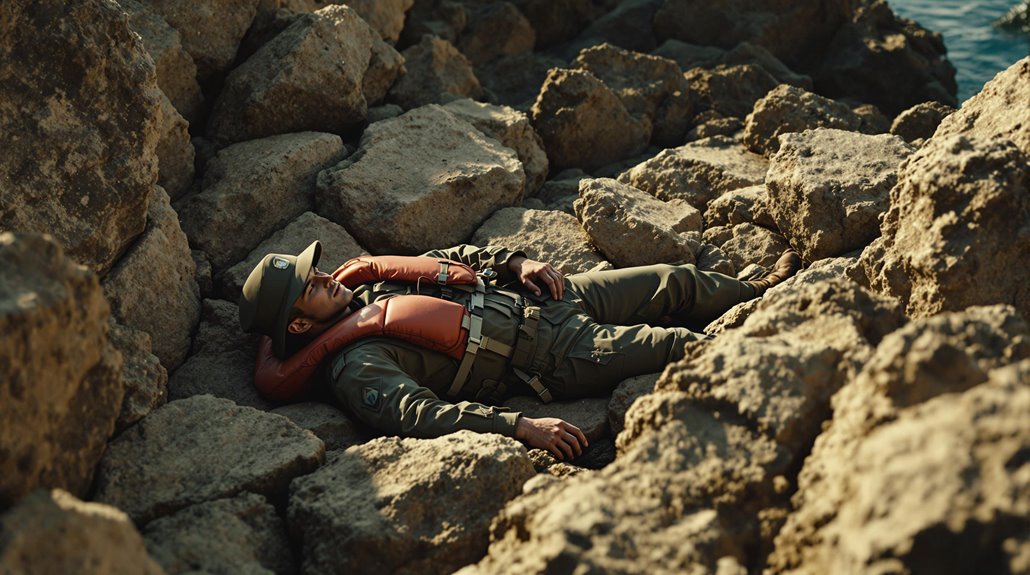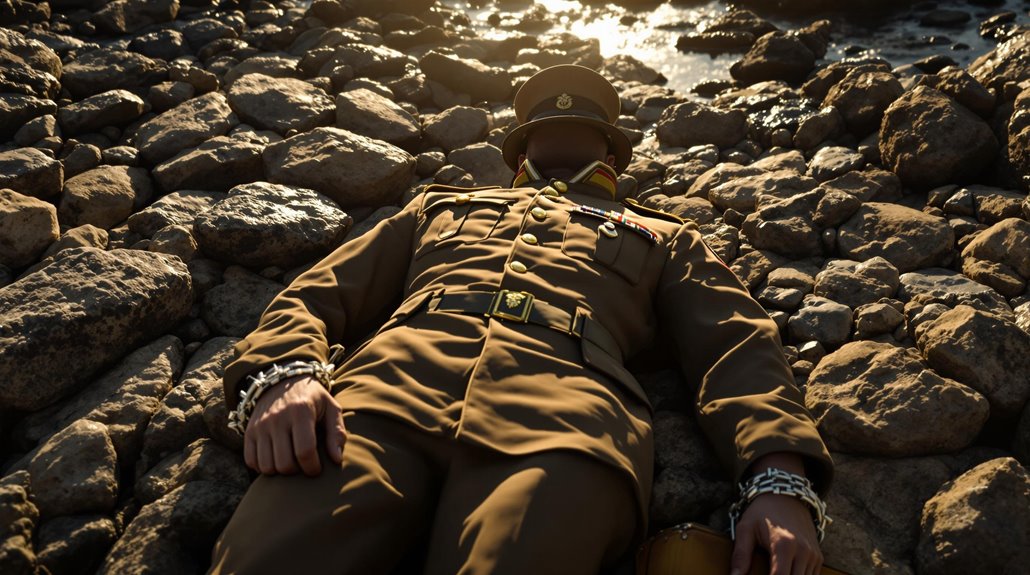Corpse Deception: The Body That Fooled the Nazis
You've probably heard incredible tales of wartime espionage, but none quite match the audacity of Operation Mincemeat. In 1943, British intelligence officers transformed a homeless man's corpse into a fake Royal Marines officer, complete with fabricated love letters and theater tickets in his pockets. It wasn't just a elaborate ruse – this dead man's mission would save thousands of Allied lives and help turn the tide of World War II in the Mediterranean theater.
The Making of a Military Ghost

When British intelligence needed a corpse to deceive Nazi Germany in 1943, they found their perfect candidate in Glyndwr Michael, a homeless Welsh man who'd died from rat poison.
The identity creation process transformed Michael into Captain William 'Bill' Martin of the Royal Marines, a carefully crafted persona that took three months to develop.
Through strategic planning, intelligence officers meticulously assembled everything needed to make Martin seem real. They issued him identity card No148228 and created an extensive collection of personal documents to support his backstory. Much like the Ghost Army troops who masterfully deceived German forces with inflatable equipment, these intelligence officers paid remarkable attention to detail.
You'd be amazed at the attention to detail – from his uniform and accessories to consulting with pathologist Sir Bernard Spilsbury about maintaining the body's condition in cold storage.
Every aspect of Martin's fictional life had to withstand intense scrutiny to fool the enemy. The operation proved wildly successful when German forces diverted 90,000 troops away from Sicily based on the planted intelligence.
A Dead Man's Deadly Mission
Three key elements made Operation Mincemeat's execution both daring and brilliant.
First, you'll marvel at how HMS Seraph's crew released the corpse off Spain's coast, knowing its deadly secrets would soon reach Nazi intelligence.
Second, the ghostly tactics worked perfectly – Spanish fishermen discovered "Major Martin" exactly as planned, and his briefcase of false documents made its way through Spanish officials to German hands.
Finally, you can see Hitler's reaction proved the deception's success. He fell completely for the ruse, ordering Panzer divisions to defend Greece and Sardinia instead of Sicily. Like Operation Albany's low altitude approach, this clever deception helped avoid German detection. The operation was so effective that Ultra decrypts confirmed the Germans believed every word.
This fatal mistake left the real invasion target vulnerable, allowing Allied forces to capture Sicily with fewer casualties than expected.
The operation's impact was so significant, it even helped topple Mussolini's regime.
Operation Mincemeat Takes Shape
Behind every great deception lies meticulous planning, and Operation Mincemeat exemplified this truth. In the historical context of 1943, British intelligence officers Ewen Montagu and Charles Cholmondeley transformed deception techniques first proposed in the 1939 Trout Memo into a daring strategy.
You'll find the operation's brilliance in its attention to detail. They created an entirely fictional Royal Marines officer, Major William Martin, using the body of Glyndwr Michael. The idea was inspired by a Basil Thomson novel.
Every element was carefully crafted – from his uniform and ID cards to personal effects like theater tickets and a photograph of a fictitious fiancée. The crowning touch was a briefcase containing falsified documents suggesting Greece and Sardinia as invasion targets, deliberately misdirecting Nazi intelligence from the actual target: Sicily.
The operation achieved unprecedented success when German High Command was completely convinced of the false invasion plans. With approvals from Churchill and Eisenhower, the stage was set.
Spain, Germany, and the Perfect Trap
The success of Operation Mincemeat hinged on Spanish soil and German gullibility.
British intelligence chose Spain for its Nazi sympathies and network of German spies, knowing the planted body would be discovered and examined by Spanish authorities who'd share the information with Hitler's agents.
Adolf Clauss, a methodical but gullible Nazi operative in Huelva, proved to be the perfect target.
When Spanish officials recovered the briefcase-carrying corpse of "Major William Martin," they photographed the fake documents before passing them to German intelligence.
The corpse chosen for the operation was that of Glyndwr Michael, a Welshman who died from consuming rat poison.
Clauss's straightforward thinking made him unlikely to suspect such an elaborate ruse.
The plan worked brilliantly.
Hitler, convinced by the planted information, diverted significant forces from Italy to Greece.
He even doubled his troops in Sardinia to 10,000 and relocated the 1st Panzer Division from France.
The operation's success led to the full capture of Sicily in just over a month after the Allied invasion began.
Victory Through Deception: The Sicily Campaign

Operation Husky released an unprecedented Allied offensive on Sicily in July 1943, deploying 2,500 ships and marking history's largest amphibious assault to date.
Through superior military strategy and deception tactics, Allied forces under Eisenhower's command quickly gained the upper hand, with a 2:1 air superiority over Axis powers.
You'll find the campaign's success reflected in its swift progress: Patton's Seventh Army captured Palermo by July 22, while Montgomery's forces engaged German resistance at Catania. The extensive aerial bombardment of Pantelleria preceded the invasion, with over 8,000 tons of bombs dropped in just 20 days. The Allies successfully pushed forward despite Mount Etna's challenging terrain impeding the Eighth Army's advance.











